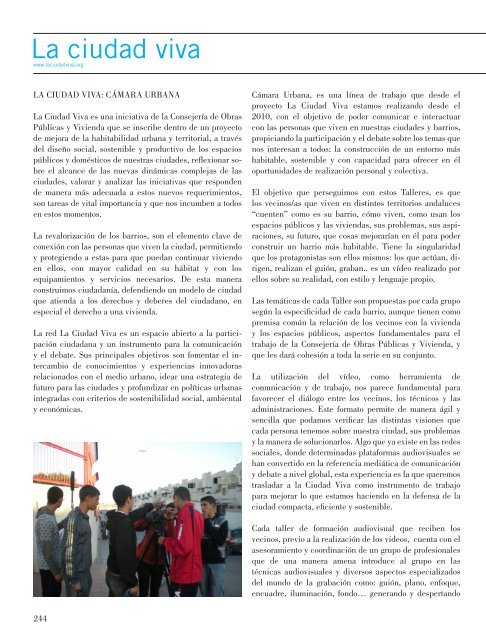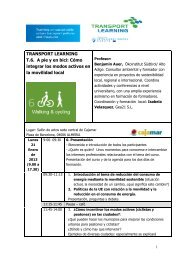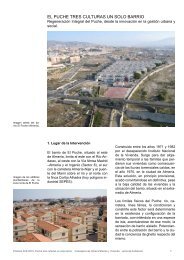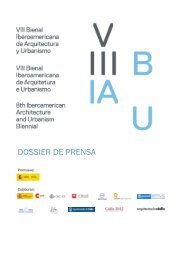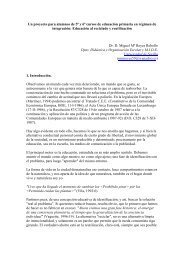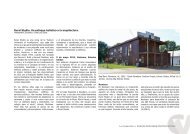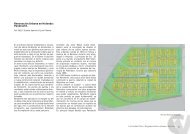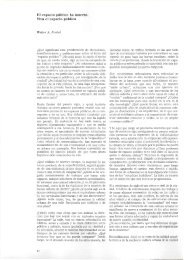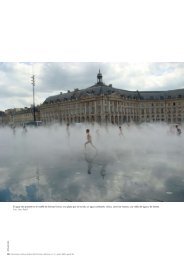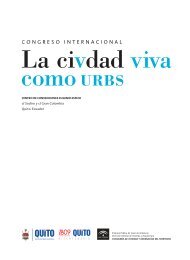You also want an ePaper? Increase the reach of your titles
YUMPU automatically turns print PDFs into web optimized ePapers that Google loves.
<strong>La</strong> <strong>ciudad</strong> <strong>viva</strong><br />
www.la<strong>ciudad</strong><strong>viva</strong>.org<br />
LA CIUDAD VIVA: CÁMARA URBANA<br />
<strong>La</strong> Ciudad Viva es una iniciativa de la Consejería de Obras<br />
Públicas y Vivienda que se inscribe dentro de un proyecto<br />
de mejora de la habitabilidad urbana y territorial, a través<br />
del diseño social, sostenible y productivo de los espacios<br />
públicos y domésticos de nuestras <strong>ciudad</strong>es, reflexionar sobre<br />
el alcance de las nuevas dinámicas complejas de las<br />
<strong>ciudad</strong>es, valorar y analizar las iniciativas que responden<br />
de manera más adecuada a estos nuevos requerimientos,<br />
son tareas de vital importancia y que nos incumben a todos<br />
en estos momentos.<br />
<strong>La</strong> revalorización de los barrios, son el elemento clave de<br />
conexión con las personas que viven la <strong>ciudad</strong>, permitiendo<br />
y protegiendo a estas para que puedan continuar viviendo<br />
en ellos, con mayor calidad en su hábitat y con los<br />
equipamientos y servicios necesarios. De esta manera<br />
construimos <strong>ciudad</strong>anía, defendiendo un modelo de <strong>ciudad</strong><br />
que atienda a los derechos y deberes del <strong>ciudad</strong>ano, en<br />
especial el derecho a una vivienda.<br />
<strong>La</strong> red <strong>La</strong> Ciudad Viva es un espacio abierto a la participación<br />
<strong>ciudad</strong>ana y un instrumento para la comunicación<br />
y el debate. Sus principales objetivos son fomentar el intercambio<br />
de conocimientos y experiencias innovadoras<br />
relacionados con el medio urbano, idear una estrategia de<br />
futuro para las <strong>ciudad</strong>es y profundizar en políticas urbanas<br />
integradas con criterios de sostenibilidad social, ambiental<br />
y económicas.<br />
Cámara Urbana, es una línea de trabajo que desde el<br />
proyecto <strong>La</strong> Ciudad Viva estamos realizando desde el<br />
2010, con el objetivo de poder comunicar e interactuar<br />
con las personas que viven en nuestras <strong>ciudad</strong>es y barrios,<br />
propiciando la participación y el debate sobre los temas que<br />
nos interesan a todos: la construcción de un entorno más<br />
habitable, sostenible y con capacidad para ofrecer en él<br />
oportunidades de realización personal y colectiva.<br />
El objetivo que perseguimos con estos Talleres, es que<br />
los vecinos/as que viven en distintos territorios andaluces<br />
“cuenten” como es su barrio, cómo viven, como usan los<br />
espacios públicos y las viviendas, sus problemas, sus aspiraciones,<br />
su futuro, que cosas mejorarían en él para poder<br />
construir un barrio más habitable. Tiene la singularidad<br />
que los protagonistas son ellos mismos: los que actúan, dirigen,<br />
realizan el guión, graban.. es un vídeo realizado por<br />
ellos sobre su realidad, con estilo y lenguaje propio.<br />
<strong>La</strong>s temáticas de cada Taller son propuestas por cada grupo<br />
según la especificidad de cada barrio, aunque tienen como<br />
premisa común la relación de los vecinos con la vivienda<br />
y los espacios públicos, aspectos fundamentales para el<br />
trabajo de la Consejería de Obras Públicas y Vivienda, y<br />
que les dará cohesión a toda la serie en su conjunto.<br />
<strong>La</strong> utilización del vídeo, como herramienta de<br />
comunicación y de trabajo, nos parece fundamental para<br />
favorecer el diálogo entre los vecinos, los técnicos y las<br />
administraciones. Este formato permite de manera ágil y<br />
sencilla que podamos verificar las distintas visiones que<br />
cada persona tenemos sobre nuestra <strong>ciudad</strong>, sus problemas<br />
y la manera de solucionarlos. Algo que ya existe en las redes<br />
sociales, donde determinadas plataformas audiovisuales se<br />
han convertido en la referencia mediática de comunicación<br />
y debate a nivel global, esta experiencia es la que queremos<br />
trasladar a la Ciudad Viva como instrumento de trabajo<br />
para mejorar lo que estamos haciendo en la defensa de la<br />
<strong>ciudad</strong> compacta, eficiente y sostenible.<br />
Cada taller de formación audiovisual que reciben los<br />
vecinos, previo a la realización de los videos, cuenta con el<br />
asesoramiento y coordinación de un grupo de profesionales<br />
que de una manera amena introduce al grupo en las<br />
técnicas audiovisuales y diversos aspectos especializados<br />
del mundo de la grabación como: guión, plano, enfoque,<br />
encuadre, iluminación, fondo… generando y despertando<br />
244
Vecinos de Puche (Almería) realizando el Taller de Cámara Urbana. 2010<br />
Neighbours of Puche (Almería) carrying out Workshop of Cámara Urbana. 2010<br />
nuevas inquietudes sobre el mundo audiovisual, más allá<br />
de las que pudieran conocer como meros espectadores.<br />
El resultado de esta experiencia es una serie de documentales<br />
de CÁMARA URBANA disponibles a través de la página<br />
web de <strong>La</strong> Ciudad Viva dentro de nuestro canal de TV.<br />
Datos técnicos<br />
Duración apróximada: 3:20 min<br />
Idioma audio: Castellano<br />
Idioma subtitulos: Inglés<br />
245
Vecinos de San Martín de Porres (Córdoba) realizando el Taller de Cámara Urbana. 2010<br />
Neighbours of San Martín de Porres (Córdoba) carrying out Workshop of Cámara Urbana. 2010<br />
LA CIUDAD VIVA<br />
<strong>La</strong> Ciudad Viva is an initiative of the Consejería de Obras<br />
Públicas y Vivienda which is part of a project to improve urban<br />
livability and territorial through the social, sustainable<br />
and productive design of the public and domestic spaces<br />
of our cities. Reflecting on the scope of the new complex<br />
dynamics of cities, evaluate and analyze the initiatives that<br />
answer more adequately to these new requirements are vital<br />
tasks that concern us all now.<br />
The increase in value of the neighborhoods is the key element<br />
of connection with people who live the city, allowing<br />
and protecting to them for the continuity of the living in<br />
the areas with higher quality in their habitat and with the<br />
necessary services and equipments. In this way we build<br />
citizenship, defending a city model that addresses the rights<br />
and duties of citizens, especially the right to housing.<br />
<strong>La</strong> Ciudad Viva network is an open forum for citizen par-<br />
ticipation and a tool for communication and debate. It is<br />
also an innovative strategy to modify the current model of<br />
public management from administration, citizens, research,<br />
and business activities. Its main objectives are promoting<br />
the interchange of knowledge and innovative experiences<br />
related to the urban environment, conceiving a future strategy<br />
for cities and deepening in integrated urban policies<br />
with social sustainability, environmental and economic criterions.<br />
Cámara Urbana is a working line that we are performing<br />
from <strong>La</strong> Ciudad Viva project since 2010, with the aim of<br />
communicating and interacting with people living in our<br />
cities and neighborhoods, to bring about participation and<br />
debate on important matters which are interesting to all:<br />
the construction of a more liveable and sustainable environment<br />
with capacity to offer us opportunities for personal<br />
and collective fulfillment.<br />
The objective we pursue with these Workshops is that the<br />
246
Vecinos de San Martín de Porres (Córdoba) durante el rodaje<br />
Neighbours of San Martín de Porres (Córdoba) during the filming<br />
neighbors who live in different andalusian territories “tell<br />
us” how is their neighborhood, how they live, how they use<br />
the public spaces and housings, their problems, their aspirations,<br />
their future, which things they would improve on it<br />
to build a more liveable neighborhood. It is a singular activity<br />
because they are the own figures: those who act, direct,<br />
script, record … is a video performed by them about their<br />
reality, with style and own language.<br />
The topics of each Workshop are proposed by the neighbors<br />
according to the objectives of each neighborhood, although<br />
they have as a common premise the relationship of neighbors<br />
to housing and public spaces, important aspects to the<br />
work of the Consejería de Obras Públicas y Vivienda, which<br />
will give cohesion to all the workshops as a whole.<br />
The use of video as a tool of communication and working,<br />
it seems crucial to promote the dialogue between residents,<br />
technicians and the administrations. This format allows<br />
easy and quickly the verification of the different visions of<br />
each person has about our city, its problems and the way<br />
to solve them. Something that happens in social networks,<br />
where some audio-visual platforms have become a media<br />
reference of communication and debate globally. This experience<br />
is the one we want to transfer to <strong>La</strong> Ciudad Viva as a<br />
working instrument to improve what we are doing in defending<br />
a compact, efficient and sustainable city.<br />
Previously to the videos making each audiovisual workshop,<br />
which train to neighbors, countes with the advising<br />
and coordination of a professional team that in a friendly<br />
way introduce to the group in the audiovisual techniques<br />
and different specialized aspects of the recording world<br />
such as: script, shot, focus, framing, lighting, background ...<br />
generating and raising new questions about the audiovisual<br />
world, beyond that may be known as spectators.<br />
The result of this experience is a documentary series CÁ-<br />
MARA URBANA available through the website of <strong>La</strong> Ciudad<br />
Viva in our TV channel.<br />
247
<strong>La</strong> <strong>ciudad</strong> <strong>viva</strong><br />
www.la<strong>ciudad</strong><strong>viva</strong>.org<br />
<strong>La</strong> Ciudad Viva. RedesSociales<br />
<strong>La</strong> Ciudad Viva. Social Networks<br />
LA CIUDAD VIVA.<br />
> .<br />
Ramón Folch<br />
<br />
Declaración de la Carta de Aalborg, 1994.<br />
El boom inmobiliario de la última década tocó a su fin. Un<br />
rápido balance del mismo permite observar algunas de sus<br />
repercusiones más positivas (rápido crecimiento del PIB,<br />
bajas tasas de desempleo..), pero también permite apuntar<br />
algunas cuestiones relativas a su lado oscuro de cuya<br />
corrección depende, en gran parte, el futuro de nuestras<br />
<strong>ciudad</strong>es, de su sostenibilidad y de su calidad de vida democrática.<br />
El crecimiento de la desigualdad social se ha traducido y,<br />
a su vez, se ha apoyado y reforzado por una creciente segregación<br />
urbana y territorial que está poniendo en peligro<br />
la propia sostenibilidad medioambiental de nuestras <strong>ciudad</strong>es<br />
y, por ende, de nuestras actuales formas de vida. Los<br />
sectores sociales más acomodados, arrastrando en este movimiento<br />
a amplios sectores de las clases medias, optaron<br />
por el “sueño” de la vivienda unifamiliar en urbanizaciones<br />
cerradas, baste recordar que más del 80% de las nuevas<br />
viviendas construidas a partir del año 1995 son unifamiliares,<br />
potenciando de esta forma la extensión irracional de la<br />
248
Página web de <strong>La</strong> Ciudad Viva<br />
Webpage of <strong>La</strong> Ciudad Viva<br />
<strong>La</strong> Ciudad Viva. Blog<br />
<strong>La</strong> Ciudad Viva. Blog<br />
mancha urbana. De este modo, frente al modelo de <strong>ciudad</strong><br />
andaluza, compacta y mediterránea, más integrada socialmente<br />
y más sostenible medioambientalmente, durante los<br />
años del boom han visto agudizarse las tendencias hacia un<br />
modelo de <strong>ciudad</strong> difusa y diseminada, “a la americana”,<br />
con fuertes déficits de equipamientos sociales y de servicios<br />
públicos y con una carga medioambiental insostenible.<br />
El programa <strong>La</strong> Ciudad Viva nace en 2007 con la intención<br />
de dar respuesta a esta necesidades <strong>ciudad</strong>anas partiendo<br />
de una Red que se constituya como un laboratorio urbano y<br />
social, donde personas, profesionales, instituciones provenientes<br />
de distintos territorios, países, <strong>ciudad</strong>es, etc impulsen<br />
un amplio debate social donde definir esa <strong>ciudad</strong> que<br />
queremos, ”<strong>La</strong> Ciudad Viva”.<br />
Este impulso reflexivo y lo más amplio posible parte desde<br />
la multidisciplinaridad y la participación compartida por<br />
todos los agentes urbanos, para generar un constante debate<br />
que nos lleve a definir cuales deberían ser los modelos de<br />
desarrollo urbano para la <strong>ciudad</strong> del futuro y que, al mismo<br />
tiempo, nos permita actualizar las actuales <strong>ciudad</strong>es compactas.<br />
Un reto que se plantea cuatro puntos:<br />
la democracia y la participación.<br />
la integración y la cohesión social.<br />
la sostenibilidad energética y ambiental.<br />
la generación de una <strong>ciudad</strong> habitable.<br />
<strong>La</strong> Ciudad Viva se inscribe dentro de un proyecto de la<br />
Consejería de Obras Públicas y Vivienda de la Junta de<br />
Andalucía para la mejora de la habitabilidad urbana y territorial,<br />
a través del diseño social, sostenible y productivo<br />
de los espacios públicos y domésticos de nuestras <strong>ciudad</strong>es<br />
donde valorar y analizar las iniciativas que responden de<br />
manera más adecuada a estos nuevos requerimientos.<br />
Queremos asimilar el concepto de “<strong>ciudad</strong> <strong>viva</strong>” a una <strong>ciudad</strong><br />
habitable en el tiempo y en el espacio, como sistema<br />
físico y como sistema social con capacidad de ofrecer al<br />
<strong>ciudad</strong>ano oportunidades de realización personal y colec-<br />
249
tiva. Trabajar por este modelo significa lograr una <strong>ciudad</strong><br />
sostenible ambiental y socialmente, y por tanto es una responsabilidad<br />
que debemos asumir como sociedad en su<br />
conjunto.<br />
<strong>La</strong> red <strong>La</strong> Ciudad Viva es un espacio abierto a la participación<br />
<strong>ciudad</strong>ana y un instrumento para la comunicación y el<br />
debate. Es además, una estrategia innovadora que supone<br />
modificar el modelo actual de gestión pública, entre administración,<br />
<strong>ciudad</strong>anos, investigación y actividad empresarial.<br />
Sus principales objetivos son fomentar el intercambio<br />
de conocimientos y experiencias innovadoras relacionados<br />
con el medio urbano, idear una estrategia de futuro para las<br />
<strong>ciudad</strong>es y profundizar en políticas urbanas integradas con<br />
criterios de sostenibilidad social, ambiental y económicas.<br />
URBS. <strong>La</strong> generación de una <strong>ciudad</strong> habitable. Rehabilitación<br />
y espacio público<br />
<strong>La</strong> revalorización de los barrios, son el elemento clave de<br />
conexión con las personas que viven la <strong>ciudad</strong>, permitiendo<br />
y protegiendo a estas para que puedan continuar viviendo<br />
en ellos, con mayor calidad en su hábitat y con los equipamientos<br />
y servicios necesarios. De esta manera construimos<br />
<strong>ciudad</strong>anía, defendiendo un modelo de <strong>ciudad</strong> que atienda<br />
a los derechos y deberes del <strong>ciudad</strong>ano, en especial el derecho<br />
a una vivienda.<br />
Este compromiso que se inició en 1984 con la transferencia<br />
de competencias en materia de vivienda a la Comunidad<br />
Autónoma Andaluza puso en marcha el desarrollo de<br />
instrumentos y reglamentos para el que respaldaran estas<br />
políticas y que culminaron en Programas de Rehabilitación<br />
de Viviendas en todos las <strong>ciudad</strong>es y pueblos de Andalucía.<br />
Desde 1984 hasta la fecha se han rehabilitado más de<br />
550.000 viviendas en Andalucía.<br />
Desde el año 1999, y en especial con el IV Plan Andaluz de<br />
Vivienda y Suelo 2004-2008 se apuesta por la recuperación<br />
Urbana de los Centros Históricos y Barrios dando lugar a<br />
Áreas de Rehabilitación Concertada para la intervención<br />
integral en estos espacios en los que concurren especiales<br />
problemas urbanos, sociales y económicos. Rehabilitación<br />
Integral porque no está supeditada únicamente al plano físico<br />
o urbano sino que integra educación, formación, empleo,<br />
trabajo socio-comunitario, etc.<br />
<strong>La</strong> Ciudad Viva a través del proyecto Cámara Urbana ha<br />
trabajado en estos barrios, con el objetivo de poder comunicar<br />
e interactuar con las personas que viven en nuestras<br />
<strong>ciudad</strong>es y barrios, propiciando la participación, el debate<br />
y su implicación sobre temas fundamentales en los procesos<br />
de rehabilitación como la construcción de un entorno más<br />
habitable y sostenible o la capacidad del entorno urbano<br />
para ofrecer en él oportunidades de realización personal y<br />
colectiva.<br />
En la actualidad <strong>La</strong> Ciudad Viva a través de Cámara Urbana<br />
ha recorrido dos de los más de 43 ámbitos urbanos donde<br />
la Junta de Andalucía está actuando estando previsto incorporar<br />
tres nuevas localizaciones dentro del mismo proyecto.<br />
“El derecho a la <strong>ciudad</strong> no es tan solo el derecho a usarla,<br />
sino también el derecho a interpretarla, a identificarnos<br />
con ella, a apropiarnos (aunque sea simbólicamente) de<br />
sus espacios, a “privatizar” lo público y a “publicitar” lo<br />
privado, de manera fluida, espontánea, creativa. Así, se<br />
encuentra la recuperación del espacio urbano como espacio<br />
vivo…”<br />
Esta cita correspondiente al texto Espacio privado, espacio<br />
público: Dialécticas urbanas y construcción de significados<br />
del autor Sergi Valera recoge en su última parte un aspecto<br />
fundamental dentro de los intereses de <strong>La</strong> Ciudad Viva como<br />
es el espacio público como espacio vivo, activador urbano.<br />
Experiencias como “Pedagogía del Hábitat”, buena práctica<br />
recogida dentro del catálogo de la página web y reflejada<br />
a su vez en sendos artículos del blog de <strong>La</strong> Ciudad Viva,<br />
cumple estos objetivos iniciando y sosteniendo una participación<br />
social, sensibilizadora y rehabilitadora dentro no<br />
solo de la vivienda sino del espacio público dentro de un<br />
ámbito de actuación. O por ejemplo, la campaña de sensibilización<br />
“Cuido mi casa, cuido mi barrio” que nace como<br />
un proyecto socioeducativo puntual asociado a la población<br />
infantil y tiene como objetivo potenciar el aprendizaje de<br />
buenas prácticas en el uso y cuidado de la vivienda, del<br />
espacio público y del medio ambiente.<br />
Todas estas experiencias más aquellas que han tratado numerosos<br />
de nuestro corresponsales como Ecosistema Urbano,<br />
Ethel Barahona, Stepien y Barno, etc. en nuestro blog<br />
vienen a reflejar nuestro interés por el espacio público. Un<br />
interés cada vez más creciente y que se suma a otra de las<br />
temáticas que abordamos desde el proyecto <strong>La</strong> Ciudad Viva<br />
250
como es el espacio digital.<br />
Casi sin darnos cuenta ha pasado una década desde que Javier<br />
Echeverría acuñó el término de “tercer entorno” en su<br />
libro “Los señores del aire”. Con él se describía una nueva<br />
sociedad que estaba en esos momentos en plena ebullición<br />
tecnológica. <strong>La</strong> era digital, que como decía Jordi Pericot,<br />
“permite la participación, sin privilegios ni prejuicios, de<br />
todos los individuos que, en un permanente aquí y allá y un<br />
ahora y un después, se encuentran y se agrupan en red para<br />
expresar sus opiniones y creencias...” se encuentra ya plenamente<br />
vigente y este intercambio abierto de experiencias<br />
hace que los <strong>ciudad</strong>anos, se conviertan en actores directos<br />
del espacio público y por tanto con plena capacidad para<br />
su transformación.<br />
<strong>La</strong> Ciudad Viva apostó desde su inicio por trabajar de manera<br />
innovadora desde la Red, el gran espacio público de<br />
nuestro presente, con el objetivo de integrar y transferir el<br />
conocimiento producido desde diferentes territorios a todos<br />
los <strong>ciudad</strong>anos. Desde esta nueva óptica el proyecto de<br />
<strong>La</strong> Ciudad Viva se ha convertido en un gran aglutinador<br />
de experiencias propias y ajenas. A través de diferentes<br />
convocatorias tanto de videos como de buenas prácticas<br />
hemos intentando recoger no solo las políticas públicas<br />
de regeneración del espacio público y arquitectónico sino<br />
abrir la puerta también a nuevos formatos de expresión y de<br />
comunicación, y a experiencias más íntimas y personales<br />
que a su vez nos revelan nuevos registros de las <strong>ciudad</strong>es<br />
donde habitamos.<br />
Por tanto este trabajo en el desarrollo de la identidad digital<br />
del proyecto, las redes sociales y el uso de las nuevas<br />
tecnologías son una buena herramienta para organizar<br />
iniciativas individuales y colectivas, así como para diseñar<br />
nuevos conceptos desde el interior de la <strong>ciudad</strong>anía siendo<br />
frecuentemente el espacio público el lugar por excelencia<br />
de libre experimentación de estas iniciativas.<br />
Desde este convencimiento, el fomento de la participación<br />
y la comunicación tanto en el espacio público como en digital<br />
conseguirá que los lugares vuelva a hablar de nosotros y<br />
es posible que como consecuencia volvamos a interesarnos<br />
por las características (calidades) físicas de nuestro entorno.<br />
Para acabar recordando a uno de los pioneros en hablar<br />
de arquitectura de participación, Ralph Erskine que<br />
en 1948, se reunión a 160 Km de Estocolmo con la mayor<br />
parte de los habitantes de la zona: esquimales, sureños, y<br />
colonos, etc. para la creación del nuevo poblado. Desde allí<br />
se hizo esta reflexión:<br />
.<br />
Y por último no podemos dejar pasar otro de los aspectos<br />
capitales de las políticas urbanas que se abordan desde<br />
la Consejería de Obras Públicas y Vivienda como es el de<br />
la sostenibilidad. Sostenibilidad que como hemos citado<br />
anteriormente no es sólo una cuestión medioambiental,<br />
como habitualmente se tiende a creer, sino que es también<br />
una cuestión social atañe al corazón de nuestra vida<br />
democrática.<br />
<strong>La</strong> reflexión sobre la sostenibilidad medioambiental obliga<br />
a modificar dicha perspectiva. En efecto, como es sabido<br />
por todos, la participación directa del <strong>ciudad</strong>ano como<br />
“consumidor” en la creación de la huella ecológica de sus<br />
<strong>ciudad</strong>es es un componente decisivo de la misma. Por ello,<br />
sin la implicación y responsabilización directa de esa misma<br />
<strong>ciudad</strong>anía no hay solución democrática posible a este<br />
problema. Ahora bien, no puede haber responsabilización<br />
<strong>ciudad</strong>ana en el cuidado de la <strong>ciudad</strong>, los <strong>ciudad</strong>anos no<br />
pueden sentir suya la <strong>ciudad</strong> y hacerse cargo más responsable<br />
de la misma si no la hacen suya, si no participan más<br />
directa y democráticamente en la gestión de “su” <strong>ciudad</strong>.<br />
<strong>La</strong> participación y la responsabilidad “delegada” siendo<br />
necesaria es insuficiente para hacer frente a los retos<br />
derivados de sostenibilidad en su triple vertiente social,<br />
medioambiental y democrática. Sin un nuevo impulso en la<br />
democratización de nuestras <strong>ciudad</strong>es y en la participación<br />
<strong>ciudad</strong>ana en su gestión muy difícilmente podemos hacer<br />
frente a los retos derivados de su actual insostenibilidad<br />
social y medioambiental de nuestras <strong>ciudad</strong>es.<br />
A través del proyecto <strong>La</strong> Ciudad Viva hemos impulsado la<br />
reflexión e investigación entorno a esta cuestión primordial<br />
a través de las jornadas “Obsolescencias Urbanas” que<br />
251
tuvieron lugar Sevilla en Febrero de 2010 y también<br />
mediante la difusión de trabajos y artículos de investigación<br />
a través de nuestra propia publicación digital Revista CV.<br />
Finalmente no podemos dejar de enumerar algunos<br />
resultados del trabajo realizado hasta ahora de los cuales<br />
queremos destacar los siguientes datos:<br />
<strong>La</strong> participación de los <strong>ciudad</strong>anos ha contribuido a la<br />
modificación del imaginario colectivo al poder contribuir<br />
en la transición de la <strong>ciudad</strong> dormitorio hacia una <strong>ciudad</strong><br />
completa.<br />
Se ha constituido una red que integra a más de 6.000<br />
<strong>ciudad</strong>anos que colaboran y participan activamente en el<br />
proyecto desde diversas puntos del planeta.<br />
Hemos conseguido incorporar, desde el 2008, un proyecto<br />
de la Administración Pública a las redes sociales, como<br />
medio de comunicación y difusión, sin límites geográficos<br />
ni temporales, para permitir la interacción entre <strong>ciudad</strong>ano<br />
e institución.<br />
El establecido de una vinculación con universidades<br />
andaluzas, españolas y latinoamericanas, colectivos,<br />
otras instituciones, pequeñas empresas... para seguir<br />
profundizando en la educación cívica a través de la<br />
investigación y el debate. Fruto de esta colaboración se<br />
realizaron los Congresos de <strong>La</strong> Ciudad Viva (Sevilla, 2008)<br />
y <strong>La</strong> Ciudad Viva como urbs (Quito, 2009).<br />
Se han intercambiado experiencias de más de catorce países<br />
diferentes y más de 180 videos urbanos, constituyéndose un<br />
catálogo y una videoteca públicas.<br />
Hemos recopilado y organizado más de 850 documentos<br />
que constituyen un Banco Común de Conocimiento a<br />
través del Archivo online. Además hemos incorporado a la<br />
Wikipedia a través del Wikiproyecto <strong>La</strong> Ciudad Viva más<br />
de 20 definiciones sobre temas urbanos para la construcción<br />
colectiva de un lenguaje común donde <strong>ciudad</strong>anía,<br />
técnicos y administraciones tengamos un marco para el<br />
entendimiento.<br />
><br />
Aristóteles <strong>La</strong> Política.<br />
LA CIUDAD VIVA.<br />
<br />
Ramón Folch.<br />
< ><br />
Declaration letter Aalborg 1994.<br />
The housing boom of the last decade come to an end. A<br />
quick assessment of it, we permit to observe, some of the<br />
most positive impact. ( Rapid GDP growth, low unemployment…)<br />
But also, we can point out some issues concerning<br />
to the dark side of correction which depends, in large part,<br />
the future of our cities, of its sustainability and quality of<br />
democratic life.<br />
The growth of social inequality has been translated and, in<br />
turn, has supported and strengthened by a growing urban<br />
and territorial segregation is threatening the environmental<br />
sustainability of our own cities and, therefore, our current<br />
lifestyles.<br />
Wealthier social sectors, dragging in this movement to wide<br />
sectors of the middle class, chose the “dream” of the family<br />
house in gated communities, suffice it to note that over 80%<br />
of new homes built after 1995 are houses, thus enhancing<br />
the extent of the urban irrational. Thus, compared to<br />
Andalusian city model, compact and Mediterranean, more<br />
socially integrated and more environmentally sustainable<br />
during the boom years have been exacerbated tendencies<br />
toward a model of diffuse and widespread city, “American”<br />
with strong deficits of social facilities and public services<br />
and an unsustainable environmental load.<br />
<strong>La</strong> Ciudad Viva program started in 2007 with the intention<br />
of responding to the needs of citizens based on a network<br />
that was established as an urban and social laboratory,<br />
252
where people, professionals, institutions from different regions,<br />
countries, cities, etc. promote a broad social debate<br />
where we want to define this city, “<strong>La</strong> Ciudad Viva”.<br />
Momentum reflective part from a multidisciplinary and the<br />
participation shared for all urban actors, to generate a constant<br />
debate, in order to define, which were the models of<br />
urban development for the city of future, and, at the same<br />
time, allows us to update the existing compact cities, a challenge<br />
that arises at 4 points:<br />
Democracy and participation.<br />
Integration and social cohesion.<br />
Energy and environmental sustainability.<br />
Generation of a livable city.<br />
<strong>La</strong> Ciudad Viva is part of a project of Consejería de Obras<br />
Públicas de la Junta de Andalucía, to improve the urban<br />
and territorial livability through sustainable social design<br />
and productive public and domestic spaces of our cities,<br />
where we can evaluate and analyze the initiatives that respond<br />
more adequately to these new requirements.<br />
We want to assimilate the concept of <strong>La</strong> Ciudad Viva of a<br />
livable city in time and space, as physical and social system<br />
with the capacity to provide citizens with opportunities for<br />
personal and collective accomplishments.<br />
Work for this model means, to achieve a sustainable city,<br />
environmentally and socially, and is therefore a responsibility<br />
that we take as a society as a whole.<br />
<strong>La</strong> Ciudad Viva is an open space for citizens participation<br />
and tool for communication and discussion. In addition, an<br />
innovative strategy of modifying the model of public Management<br />
between administration, citizens, research, business.<br />
Its main objectives are to promote the exchange of<br />
knowledge and innovative experiences related to urban to<br />
devise a future strategy for cities and urban policies deepen<br />
integrated with social sustainability criteria and economic<br />
environment.<br />
URBS: The generation of a livable city. Rehabilitation and<br />
public space.<br />
The revaluation of the neighborhoods are the key element<br />
of connection with people that live the city, allowing and<br />
protecting to these, that still living, with more quality in its<br />
habitat and equipments and necessary services. Thus build<br />
citizenship, defending a city model that addresses the rights<br />
and duties of citizens specially the right of a house.<br />
This compromise that started in 1984 with the devolution in<br />
housing themes to the Comunidad Autonoma Andaluza, it<br />
launched the instruments and regulations to support these<br />
politics, and it finished in housing rehabilitation programs<br />
in all towns and cities of Andalusia. From 1984 it has been<br />
rehabilitated more than 550.000 houses in Andalusia.<br />
From 1999 and specially with the IV Plan Andaluz de la<br />
vivienda y suelo 2004-2008.It is committed, to urban recovery<br />
of the historical towns and neighbors, taking place in<br />
concerted rehabilitation areas for comprehensible intervention,<br />
in these spaces in where there are special problems,<br />
economic,, social, -urban.<br />
Comprehensive rehabilitation because it is not just urban or<br />
physical, it is also education job, training, social work<br />
<strong>La</strong> Ciudad Viva through a project of urban chamber has<br />
worked in these neighborhoods, to communicate and interact<br />
with people that live in our cities and neighborhoods,<br />
encouraging the participation debate and implication in<br />
process of rehabilitation as the construction of a more habitable<br />
and sustainable environment or the capacity of an<br />
urban environment to show opportunities for personal and<br />
collective accomplishment.<br />
Nowadays <strong>La</strong> Ciudad Viva though the urban chamber has<br />
come two or more than 43 urban areas where the Junta de<br />
Andalucía is acting. It is scheduled incorporate 3 new locations<br />
in this project.<br />
“The right to the city it is not just use it .It is also the right to<br />
interpret, to identify, to appropriate of its spaces, To privatize<br />
the public and advertize the private, in a creative, spontaneous,<br />
smoothly way. Like this, it found the rehabilitation<br />
of urban space like live space.”<br />
This corresponds to the text quoted Private Space Public<br />
Space: Urbanity dialectical constructions of meaning from<br />
Sergi Valera. He explains in the last part, a fundamental<br />
aspect in the interest of <strong>La</strong> Ciudad Viva.<br />
Experiences like “pedagogy of habitat”, collecting good<br />
253
practice within the web page and reflected in two articles in<br />
the blog the living city.<br />
It meets these two objectives, initiating and sustaining a social<br />
participation, sensitizing, rehabilitation, not just inside<br />
of houses, but also in the public spaces, or for example, the<br />
awareness campaign, “I care for my home, I care neighborhood”.<br />
That it is, a social education project associated to<br />
children and it has the project to show the good manners in<br />
the use and care of housing, public space, and environment.<br />
All these experiences added to all those that our correspondents<br />
have tried like urban ecosystem, Ethel Barahona,<br />
Stepien y Barno …In blog come to reflect the interest for the<br />
public space, an increasingly common interest and adds to<br />
one of the themes we address the digital space.<br />
A decade has passed since Javier Echevarría coined the<br />
term ”third environment” in his book, “los señores del<br />
aire”. It was described a new society that it was in technological<br />
seething, the digital era, like Pericot said ” Permit<br />
the participation without privileges, prejudices to all people<br />
that in a permanent here and there, and a now and then. It<br />
found, and grouped in net, to express their opinions and<br />
beliefs.<br />
It finds current and this open exchange of experiences it<br />
makes that citizens were direct actors of the public space<br />
and therefore with full capacity of transformation.<br />
From beginning, <strong>La</strong> Ciudad Viva is working as innovate<br />
way using the net. Actually, the net is the universal public<br />
domain. The objective of the City Living is to integer and<br />
transfer the knowledge to the citizens. From this new point<br />
of view, <strong>La</strong> Ciudad Viva project becomes a site with multiples<br />
experiences by movies and good practice reports <strong>La</strong><br />
Ciudad Viva has collected the public politics to regenerate<br />
the architectonic and public space. Moreover, it has opened<br />
the door to new expression and communications formats<br />
and personal and intimate experiences that the show new<br />
things of the cities where we are living.<br />
In the development of the digital identity of the Project, the<br />
social nets and the new technologies have been some good<br />
tools to organize individual and group works and to design<br />
new concepts from the citizens. Normally, it has been the<br />
public space the site to do these works.<br />
From this methodology, promoting the participation and<br />
the communication as in the public space as in the digital<br />
world, it will get that the places speak again about us ant it<br />
is possible that as a consequence we interest by the physics<br />
characteristics (quality) of the our environment.<br />
Finally, think back to Ralph Erskine, one of the pioneers<br />
speaking about participation architecture. In 1948, Erskine<br />
was met with the habitants of a zone at 160 km from Stockholm<br />
(farmers, people from the South and Eskimos) to create<br />
a new city. In that meeting, this thinking was done:<br />
<br />
We can not forget other important aspect of the urban politics<br />
that they are made from the Consejería de Obras Públicas<br />
y Vivienda as the Sustainability. The sustainability is,<br />
as it has been said before, is an environmental question but,<br />
moreover, a social question that concern to the heart of our<br />
democratic life.<br />
A thought about the sustainability environmental does that<br />
we should modify our perspective. As we know, the direct<br />
participation of the citizen as “customer” in the creation of<br />
the ecologic traces of the cities is a decisive factor. So, if<br />
the citizens are not involved in that, it has not a democratic<br />
solution to this problem.<br />
But, it can not exist a responsibility of the citizens in attend<br />
to the city, the citizens can not perceive the city as their and<br />
they have more responsibilities, if it is not their city. The<br />
citizens have to participate in a direct way in the management<br />
of the city. The participation and the responsibility in<br />
an indirectly way is necessary but it is not enough to solve<br />
the objectives in sustainability. We need a new impulse in<br />
the democratization and responsibility in the cities to improve<br />
the actual social no sustainability and environmental<br />
problems in our cities.<br />
<strong>La</strong> Ciudad Viva project has get the thought and research<br />
about this main question by the workshop “Obsolescencias<br />
Urbanas” that it was celebrated at Sevilla February 2010<br />
254
Congreso Internacional <strong>La</strong> Ciudad Viva como Urbs. Quito. 2010<br />
International Congress. <strong>La</strong> Ciudad Viva como Urbs. Quito 2010<br />
and by the publication of research papers in our digital<br />
journal “Revista CV”.<br />
Following, it is a summary of the more relevant obtained<br />
results:<br />
The participation of the citizens has contributed to the modification<br />
of group ideas in order to move from the sleeping<br />
city to a full city.<br />
A social net has been done with more than 6000 citizens<br />
that collaborate and participate in the project from the entire<br />
world.<br />
From 2008, a project by the Public Administration has been<br />
incorporated to de social net, as a way of communication<br />
and diffusion, without geography and temporal limits, to let<br />
the interaction between the citizens and the administration.<br />
It has been established agreements with Andalusian, Spanish<br />
and South American universities, and other institutions,<br />
companies,… in order to continue improving the civic education<br />
by the research and the discussion. From this collaboration,<br />
it was made the Conferences “<strong>La</strong> Ciudad Viva”<br />
(Sevilla, 2008) and “<strong>La</strong> Ciudad Viva como urbs” (Quito,<br />
2009).<br />
It has been shared experiences with more than fourteen<br />
countries and more than 180 urban movies. So, a catalogue<br />
and a video collection have been created.<br />
It has been collected and organized more than 850 documents<br />
that they are available by a on line Bank of Knowledge.<br />
Moreover, we have incorporated to Wikipedia by<br />
<strong>La</strong> Ciudad Viva. Documentos. Buscador interactivo<br />
<strong>La</strong> Ciudad Viva. Documents. Interactive search<br />
“Wikiproyecto <strong>La</strong> Ciudad Viva” more than 20 definitions<br />
about urban topics for the collective construction in a common<br />
language where, citizens, specialists and the administration<br />
have a way for understanding.<br />
<br />
Aristóteles <strong>La</strong> Política<br />
255


